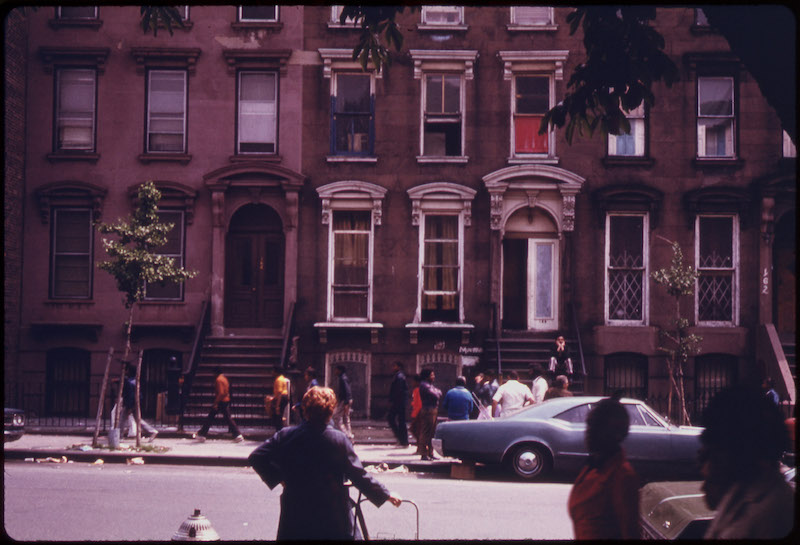Black homeownership in Brooklyn isn’t only important today — it’s an essential part of American history. In fact, there’s been a tradition of black Americans owning their homes in Brooklyn since the 19th Century.
That history might feel ancient amid the increasing debate over gentrification, displacement, and income inequality. In 2016, the Furman Center reported that about 25 percent of black households owned their homes in the borough. That rate has been falling year to year given the economic pressures on working class people of color.
As challenging as homeownership may be for all New Yorkers, there are still resources available for individuals ready to own their homes. And Brooklyn still stands tall a testament to how the black homeownership can empower and enrich our greater communities.
1. Black freedmen built one of the nation’s first black-owned communities right in the middle of Brooklyn more than 180 years ago.

Hunterfly Road Houses. Photo courtesy of Anonitect/Wikimedia Commons.
New York outlawed slavery decades before the Emancipation Proclamation, which allowed a former slave from Virginia named James Weeks to purchase a lot of land in 1838. About ten years later, more than 500 black residents called the neighborhood home.
Since its founding, Weeksville was incorporated into its surrounding neighborhoods, straddling the edge of Bed Stuy, Crown Heights, and Brownsville. Four of the historic community’s original buildings still stand as part of the Weeksville Heritage Center on Buffalo Avenue.
2. Brooklyn’s Fort Greene has been a long-standing cultural center for Black homeowners and residents.

Fort Greene Park. Photo courtesy @franciscodaum/Flickr Creative Commons.
It’s hard to separate Brooklyn culture and black history without also thinking about Fort Greene and the community members who sustain it.
As the New York Times wrote a few years ago, “by the 1970s most of the area’s homes were owned by middle-income blacks, many of whom had bought them during the white exodus for the suburbs in the ’50s and ’60s. A predominantly black creative community flourished.”
That community included artists and musicians who were able to own their homes, and it continued to flourish decades later. In 1992, Entertainment Weekly profiled Fort Greene’s “culture explosion” before and after longtime resident Spike Lee’s star began to rise:
The concentration of talent — some of today’s most influential musicians, filmmakers, writers, and artists — echoes cultural movements like Paris’ Montmartre circle in the 1880s, Greenwich Village in the 1910s, or London’s Bloomsbury group in the 1920s. Though [music producer Bill] Stephney cautions that they don’t “sit around in parlors and discuss everything from Kunta Kinte to Ice Cube,” their work voices Lee’s rallying cry: “Black life is as important as white life.”
3. Brooklyn saw a surge of new black families in the early and mid 20th century.

Photo Credit: Danny, Lyon, U.S. National Archives, via Bowery Boys blog
The Great Migration saw 6 million black Americans move out of the South, with a large number of them moving to Brooklyn over the course of decades. Around that same time, New York also saw a surge of new neighbors from the Caribbean and Central America as immigration policies would relax to allow more workers into the country.
IMPACCT Brooklyn friend Colvin Grannum of Bedford Stuyvesant Restoration Corporation detailed his own family’s experience when they came to Brooklyn for City Limits:
Immigrants from Barbados, my parents arrived in New York in the early 1950s. They settled in the western portion of Bedford Stuyvesant, now known as Clinton Hill, and were among the first Black people to purchase a home on Cambridge Place, a tree-lined street of stately brownstones. My parents “chose” Bedford Stuyvesant because it was becoming a Black neighborhood. Massive White flight — Whites selling their homes and moving from Central Brooklyn to all-White neighborhoods in Flatbush, Queens and Long Island — communicated emphatically to my parents that a Black neighborhood was where they belonged.
4. There’s been a steep decline in black homeownership in Brooklyn as well as the rest of the country.

Photo courtesy Amazon.com
Despite its long history of black homeownership, Kings County today has the fourth-lowest homeownership rate in the country. Most Brooklynites incomes just don’t line up with residential real estate prices, and residents are not immune to America’s ongoing racial wage gap.
That means many New Yorkers, especially New Yorkers of color, increasingly rely on assistance programs to become homeowners. A recent StreetEasy report found that black New Yorkers make up some 38 percent of applicants for Federal Housing Administration loans that offer more significant financial assistance.
On top of everything else, as a recent report by the Urban Center found, black Americans were demonstrably hit harder than most by the 2008 housing crisis, so much so that gains made in black homeownership rate after the Fair Housing Act was passed were effectively erased by 2015.
5. Brooklynites have a wealth of resources to make homeownership a reality today — including IMPACCT Brooklyn.

IMPACCT Brooklyn Executive Director Bernell K. Grier.
Owning a house, co-op, or condo isn’t, but there are tools and resources readily available to all Brooklynites to help them become homeowners.
Back in 1964, residents from Fort Greene and Clinton Hill founded IMPACCT Brooklyn (then known as the Pratt Area Community Council) to address neighbors’ concerns and needs as a collective of block associations. Working collaboratively, they helped open the Clinton Hill Library as well as new parks, community gardens, and buildings for tenants.
The organization is committed to the same mission more than 50 years later. Our Home Services team is ready to walk all Brooklynites considering owning their home through the process and connect them to valuable resources that can make their financial goals a reality — including down payment assistance programs first-time home buyers may be eligible for, as well as individualized finance counseling.
Register today for our First-Time Home Buyer workshop or visit with the Home Services team at our monthly Open House!


